SAEDNEWS: In the wake of the U.S. military’s unprecedented strikes on Iran’s nuclear facilities, the Gulf Cooperation Council (GCC) has issued a crucial update—no abnormal radiation has been recorded across the Persian Gulf states, dispelling widespread fears of a regional radiological emergency.

According to Saed News, the Gulf Cooperation Council (GCC) Secretariat, citing its Emergency Management Center, announced on Sunday that no traces of radioactive contamination were detected in the atmosphere of any Gulf state following the early morning U.S. airstrikes targeting Iran’s nuclear facilities in Fordow, Natanz, and Isfahan.
The Council emphasized that all environmental radiation monitoring indicators remain within normal parameters. Continuous surveillance is being conducted via early warning systems in cooperation with national authorities in each member state, and further updates will be provided as new data emerges.
Simultaneously, Saudi Arabia’s Nuclear and Radiological Regulatory Commission also issued a statement confirming that no signs of radioactive pollution have been recorded in the Kingdom’s airspace or among neighboring Gulf countries. The commission stressed that current radiation levels pose no threat to populations near the Iranian nuclear sites or across the region.
The Kuwaiti National Guard also released a bulletin confirming the absence of elevated radiation in either the atmosphere or marine zones of the country. All levels remain within the internationally accepted safety threshold.
Echoing regional reassurances, the International Atomic Energy Agency (IAEA) stated that no spike in radiation has been detected at Iran’s nuclear infrastructure—including the heavily targeted Fordow site—since the aerial bombardment conducted by U.S. forces.
While the international community remains alarmed by the broader implications of the American military intervention, especially concerning its legality and potential fallout, early monitoring reports have thus far quelled fears of environmental catastrophe.
Still, the situation remains fluid. Regional environmental and security agencies continue to monitor radiation levels around the clock, wary of delayed aftereffects or retaliatory scenarios that could destabilize environmental and human safety metrics in the region.

